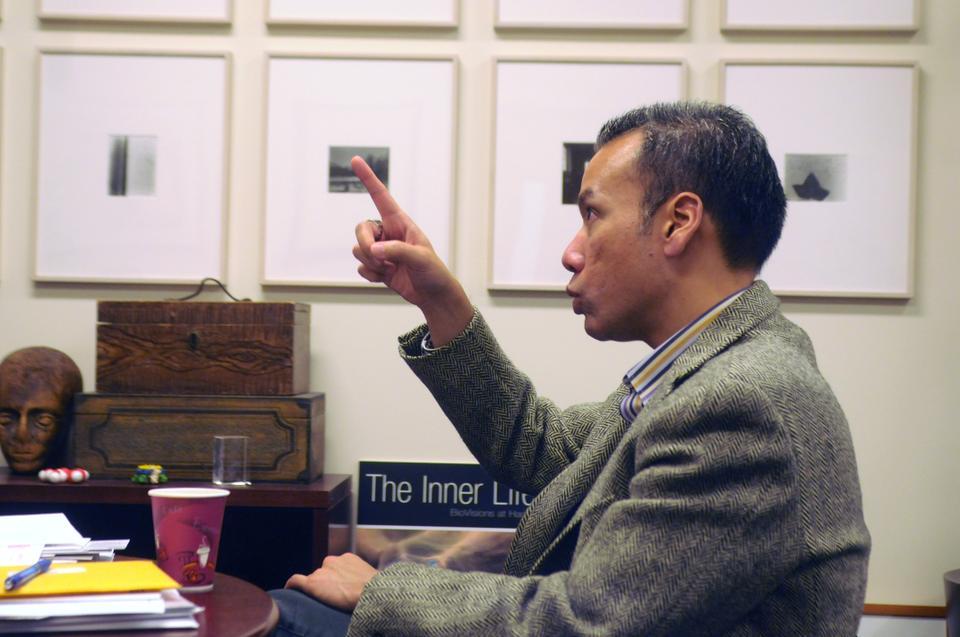
Art & Science
As far as many Harvard students today are concerned, the only points of intersection between art and science are the doodles in their LS1a notebooks. However, the separation was not always so acute. In fact, early knowledge of biology was informed as much by images as by written description. Without the aid of modern-day imaging technologies, art was scientists’ only means by which to visually communicate biological processes.
Harvard Professor Robert A. Lue is hoping to reestablish the connection between art and science. “To me it was always ironic that the first time that a cell was recorded we didn’t have cameras that could photograph,” says Lue, “so there were these beautiful ink drawings that scientists did to document the microscopic natural world as they saw it.” And yet, innovations in scientific visualization have not matched the rate of scientific discovery. Still, “visualization,” says Lue, “has not lessened in importance; it’s as important as it ever has been.”
In an effort to weave the paintbrush and petri dish back together, Lue founded BioVisions at Harvard in 2006. The project unites scientists and graphic designers to produce digital media visualizations that effectively communicate biological processes.
“In a way it was an opportunity to combine two things that I really love and especially in a way that I think could solve a problem that I’ve seen.” While students have no trouble memorizing what the functions of cellular structures are, envisioning the “inner life of the cell” still remains a mystery.
A SYMBIOTIC RELATIONSHIP
Lue knows his students. Many of those sitting in his LS1a lecture hall will likely go on to pursue careers in medicine and scientific research. In a way, BioVisions is Lue’s call for overly focused students to realize the aesthetic beauty of the natural mechanisms described in their textbooks. “I think ultimately it’s about stimulating your mind, and there are very few things that can be as provocative and stimulating as a piece of visual art. For someone who’s a future physician, scientist, poet, or writer, it is important in my opinion to keep that source, that thread of stimulation alive in your life.”
The connection between art and science is by no means a one-way street. As much as scientific concepts can be depicted through art, art and its appeal can in turn be illuminated by science. “Increasingly, especially with contemporary artists, you see a real interest not just in the imagery of the natural world as generated by science, but also in thinking about the processes of science in the production of art.”
One artist in particular whose oeuvre embodies Lue’s notion of science in art is Hans Haacke. The German-American artist draws inspiration for much of his work from closed scientific systems, biological growth, and random movements. For example, Condensation Cube (1963–5) is a moisture-filled Plexiglas container, the appearance of which is in constant flux. Haacke thus creates thought-provoking art by utilizing the basic principles of elementary-school science.
As Lue points out, science can not only inform art’s subject matter, but can also, to some extent, explain its appeal.
“I’ve always loved abstraction. It’s an interesting question: why should it be appealing to us? Part of it is that our brains have evolved to appreciate and to be sensitive to difference—to things that resemble something we recognize but are off-kilter” says Lue. “It is that difference that is so engaging. From an evolutionary standpoint, to scan a scene and pick up difference and be focused on that is in fact highly adaptive.”
INNER LIFE OF LUE
A glance into Lue’s office clarifies his involvement in the arts beyond BioVisions. On his walls hang an eclectic collection of works by such luminaries as James Welling and relatively unknown artists, including Texas-based monk Brother Jeremiah. He also admires contemporary artists such as Felix Gonzalez-Torrez, who has previously installed at the Carpenter Center, and Dana Schutz, whose work he describes as “cartoon-y, cute, and deeply off-putting.”
Looking ahead, Lue plans to expand BioVisions to incorporate chemistry and physics, noting an imminent project that will focus on the concept of randomness. “In everyday life, we tend to suppress randomness. The way that order emerges from chaos is very compelling.”
Despite Lue’s extensive background in biology, however, he believes that the most enthralling aspects of the subject are those that retain a kind of poetry. He grins while describing the background of his computer screen—a still shot from the BioVisions’ animation of the Golgi apparatus. “It looks like such a remarkable, permanent structure, but it is constantly in flux. In other words, it’s not a stable thing. If you stop the vesicles that create it, it completely disappears. It is transitory, and that is fascinating to me. There is an inherent dynamism to living systems.”


